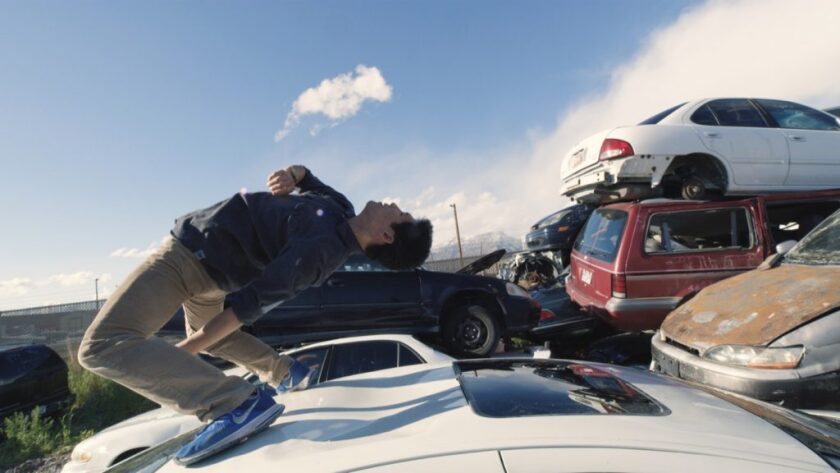BYU students, alumni, faculty and UTA personnel cooperate to create raised awareness of Utah’s air pollution situation through dance.

BYU students and alumni dance in “The Last Mile,” one of the videos in Song’s recent “Air Transit” project.
Assistant professor Keely Song believes dance can raise awareness of important issues and her recent project “Air Transit” shows how she takes her brand of dance activism in a new direction with new collaborators, new intention and a new subject: Utah’s air pollution crisis.
“Some time ago I switched from trying to make dance works to change people to making dance works to change myself,” Song said. “The creation and intent of making “Air Transit” was essentially to hold myself accountable and to change my own behavior and ideas towards riding public transit.”
The project, a series of dance videos warning of the dangers of air pollution and advocating solutions, naturally brought together film, dance and music students and faculty. Three-pronged collaborations such as these are not unusual at BYU. However, Song wanted to draw input and inspiration from new areas and disciplines. “I wanted to continue to push the collaborative boundary by working with BYU assistant professor Ben Abbot from the ecosystem ecology department,” Song said. “By incorporating an environmental expert within the film, I wanted to push the dances to a level of environmental commercial activism.”
“She came to my office and we discussed for a couple hours what the science on the subject is,” Abbott said. “I pointed her toward some interesting new research that links air quality with all these different kinds of health outcomes. She invited me to come into the studio and read some of the text we’d talked about and we also just kind of free-styled some stuff in the studio.”
Song contacted BYU’s commercial music program for assistance and Jordan Turner, Jarrett Davis, Stephen Henderson, and Jarom Hansen helped create music for the project. The composers, all current or graduated members of the BYU School of Music, created original music for each respective dance. Hansen, who composed and produced the music for “Save a Car Ride the Bus,” said, “I enjoy working with Keely because she’s cool when I mix in elements of jazz and R&B into the music I create. I like that I can express my creative voice as part of my job.”
Song also reached out to UTA officials, asking for permission to use Utah Transit Authority’s facilities and buses in the project. The organization was more than happy to help, even permitting the dance and crew to film in one of the new UVX buses.
“UTA was great,” said producer, co-director and BYU alum Scott Cook. “One of my favorite parts was our bus driver, who was hilarious. You can watch a little clip of him jamming along with us. Everyone was glad to have us there.”
The expanded collaboration allowed for new possibilities and gave participants the opportunity to fill new roles. “I’m not the sole choreographer of “Air Transit.” That title is shared between myself, BYU students and Tristan Gray,” Song said.

A BYU student joins other dancers in the junkyard for “Air Transit’s” “Ride the Bus Save A Car” video.
This collaboration of movements and choreography created a feeling of ownership and respect among the involved dance students. Tera Taylor, one of the dance students, said, “I enjoyed collaborating on this film because Keely was so willing to take our ideas and try different things with the choreography.”
The changing nature of these roles also impacted film production, causing Cook to take on greater responsibility in the project. “Once the piece got green-lit, I asked Cook to come on as co-producer,” Song said. “Eventually, his role shifted to co-director as he clearly had more skill and eye for the camera. And that is the beauty of collaboration — finding the strengths in others.” Cook agreed that collaboration enhanced the project. “They bring their separate passion and I bring my separate passion and we kind of weld it together,” he said of working with the team.
The dances themselves also challenged and excited the involved staff and dancers. One of the films, called “Inverted Rain,” provided particularly unique circumstances for the dancers and filming crew. “We weren’t really sure what to expect because we had never danced in water before, but we all decided to just go for it,” Taylor said. “Keely’s choreography definitely challenged all of us so it was very interesting collaborating and figuring out ways to perform the choreography, not only in the rain, but also on concrete.”
“Inverted Rain was the hardest shoot we did,” said Loren Cottam, one of the other dancers involved in the project. “It was at night, it was cold, we were wet and it was concrete, but it was fun. We bonded as a cast and, from what we saw of the shots, it was really cool.”
While the project collaborators come from different personal and professional backgrounds, one uniting aspect of the project is the passion participants have for air quality. “Art, in itself, is meaningful, but I think it’s especially meaningful when we can tie it to a cause and bring it to people,” Cook said.
“As Keely shared this vision I was very excited,” Cottam added. “I get to dance and be a proponent for environmentalism.”
“Air quality isn’t just some environmental issue of the day,” Abbot stated. “Between 2 and 5 thousand people are dying every year in Utah because of air pollution.” However, Abbot is certain that this can change, and it can change soon if Utahns change their perspective on pollution and public transportation.
The “Air Transit” video scenes can be viewed online here
All photos were provided courtesy of Scott Cook.